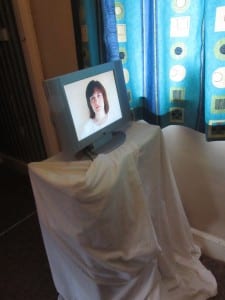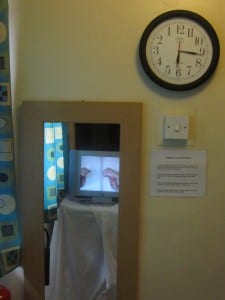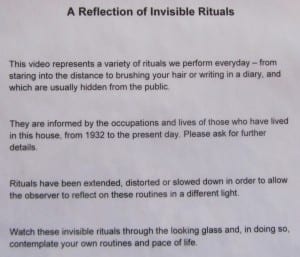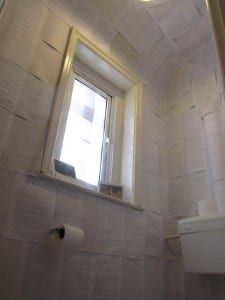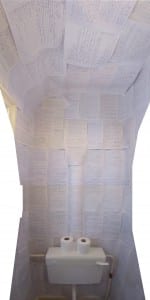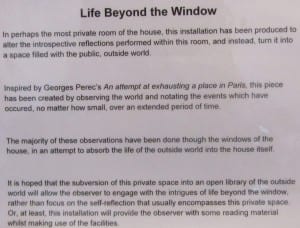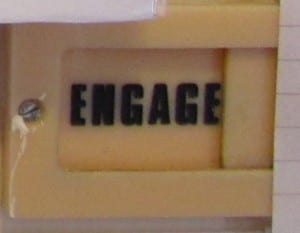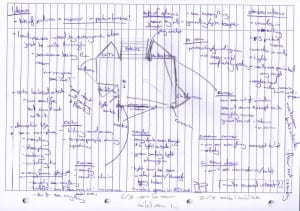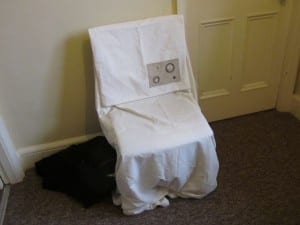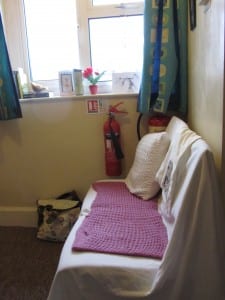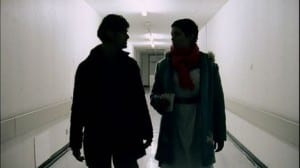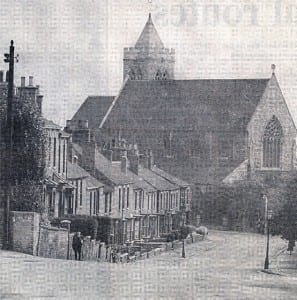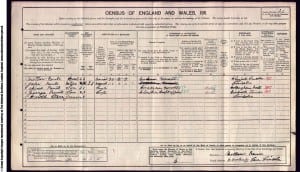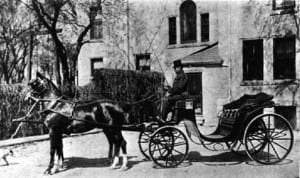Final performances
My Role
For the first two nights of our performance my role was to be a curator of my installation pieces as well as a guide telling the audience members which room to go to next. However, as I was on the landing at all times it meant that people didn’t feel free to explore the space or express opinions. This was especially true for the toilet room as even though I asked each audience member if they wanted to explore the room, only two did so.
As an experiment, on the third night I agreed with the performers in the other rooms that I would hide, mostly in the CCTV room, and observe how the audience reacted to the installations without being watched or feeling coerced. This had very encouraging results, with verbal responses to both installations replacing the silences of the first nights, and every audience member looking around the toilet installation.
A Reflection of Invisible Rituals – Video Performance/Installation
My final video consisted of six different rituals, of around two minutes each, played on an infinite loop. The order of the videos came from looking at everyday lives and the order in which people tend to do these actions; cleansing (wiping my face), drying (talcum powder), grooming (brushing hair), moisturising, daydreaming (looking into the camera) and writing in a diary (writing on a mirror). I also put a different twist on all of the videos in order to make the audience think about those actions in a different light.
Above: My final performance video. ((Louise Peason (2013) Louise’s Site Specific performance video. Available at: http://www.youtube.com/watch?v=WAwnDoNSu-A (Accessed: 12th May 2013). ))
For the cleansing, grooming and moisturising videos I tried to slow down or extend the usual way in which we would perform these actions, turning something we would do in under ten seconds, into an action extending to two minutes. This was similar for the drying, day-dreaming and writing in a diary, but as an alternative to extending the length of the ritual I altered the way in which I performed them. Instead of using talcum powder in the usual way, I poured it slowly over my feet until I was eventually covered with powder and stepped out of the frame, leaving a shadow where my feet had been. Inspired by Marina Abramovic and the story of Orpheus and Eurydice my daydreaming video comprised of me staring into the camera, as opposed to a spot in the distance, and ‘snapping out’ of the day-dream when I suddenly turn to look behind me.
For my final video I played with the idea of mirror writing (a style of writing that is also sometimes used for secret messages, like in a diary) as when reflected the backwards writing will actually read forwards. This was an interesting video to observe reactions to, to see if audience members figured out that the writing was actually created backwards.
For my set up of this installation I had intended the mirror to face the staircase so that the audience could see themselves as they came up the stairs, but due to health and safety restrictions, as well as the mirror not being free-standing, I decided to hang the mirror on the wall at a 90° angle to the stairs. This did mean that it was safer for my video monitor and stand as they were further into the landing, rather than being close to the top of the stairs. To the wall with the mirror on it I added a short description of the installation and a backwards clock to add to the theme of reflections and altering the perspective of time in which we perform the rituals. In addition it had a practical purpose, giving me a clock to keep track of where the audience members should be at particular times.
Top Left: The video monitor from the top of the stairs. ((Pearson, Louise (2013) Video Installation [Photograph]. ))
Top Right: The audience’s view of the monitor through the mirror. ((Pearson, Louise (2013) Audience’s perspective [Photograph]. ))
Below: My installation description. ((Pearson, Louise (2013) Video description [Photograph]. ))
Reactions to my video varied, with many responses that I hadn’t anticipated. An interesting comment was that my video might be a live stream of me in a different house and if they asked a question then I might respond. There were also some responses to my mirror writing with people exclaiming “she’s writing backwards on a mirror, in a mirror!” which was very satisfying as I was relieved that people understood the complexity of that clip. The most satisfying reaction to my video was in response to the hair brushing clip, when one audience member likened it to the horror film The Ring which used similar videos of everyday activities just before the girl crawls out of the screen. The audience member feigned fear that he would die in seven days or that I would come out the screen to attack them. This reaction was something I had not considered, having never watched The Ring. It was fascinating to see such a diverse range of reactions to my video, each observer’s own imagination or experiences shaping their interpretations.
If I was to ever re-film this installation or perform in the house again I would create a longer video, either by adding new rituals to it, or extending the existing videos as (due to the ten minute performances in each room) when audience members left the different rooms they always ended up seeing the same clips. I would also find a more effective way of covering my monitor stand as the sheet which covered it didn’t give a very neat finish, although it did serve the purpose effectively of hiding the DVD player and all the wiring. If I could, I would still like to try having the mirror facing the stairs rather than at an angle so that the full effect can be experienced of discovering the installation immediately when coming up the stairs. This would be useful as some audience members did not understand that the video is to be viewed through the mirror and instead stood to the side of the monitor observing it from the front. In terms of the video content I would try to create a higher quality video, experimenting even further with the speed and style of my movements as well as controlling the brightness and focus of my videos which automatically refocused at inconvenient points. I would want to re-film my talcum powder clip as the colour of the carpet was quite distracting and did not match the neutral tones of the other clips.
Life Beyond the Window – Installation
My final installation piece comprised of 50 individual sheets of observations which were photocopied several times. The reason I chose to do this rather than write an entire room’s worth of observations is the amount of time it takes to write a single sheet of A4 paper; the 50 sheets took an exceptionally long time to write by hand but when stuck up covered less than half of the narrow wall. However, the result of sticking up the large number of sheets to the walls, ceiling and both sides of the door was an impressive installation, and unless closely inspected, it was hard to tell that each page was not individual.
Left: Low angle of installation ((Pearson, Louise (2013) Low angle of the Installation [Photograph]. ))
Right: Toilet wall ((Pearson,Louise (2013) Toilet wall [Photograph]. ))
I attached a description of the installation to the door, and set the engaged/vacant sign to ‘engage’ as a subtle message to the audience to engage with the installation rather than become introverted, as is usually the case when one uses this room. I also left the light on and the door wide open so that it could be seen by people coming up the stairs.
Above: My toilet installation description ((Pearson, Louise (2013) Installation description [Photograph]. ))
Below: Engage sign ((Pearson, Louise (2013) Engage [Photograph]. ))
During the performance it was difficult to get any audible responses to this installation but over the CCTV cameras it could be seen that the toilet installation was more interesting to some audience members than the video performance; when I wasn’t on the landing the toilet room was actually the first place most audience members were drawn to. My fellow performers complimented me on how impressive the installation was and they were appreciative of having something interesting to read when they had to use the facilities.
Above: A panorama of my toilet installation. ((Louise Pearson (2013) Louise’s Installation Panorama. Available at: http://www.youtube.com/watch?v=nx2rW0kDhYE (Accessed: 12th May 2013). ))
If I was to do this again I would dedicate much more time to generating the observations so that the room could be filled with unique pages, thus making it even more impressive. I would also use different sizes, types and colours of paper in order to make the final project look more visually appealing. The variation in size would create an easier way of ‘wall-papering’ the odd shapes and pipes on the walls.
